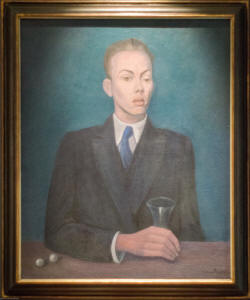

Queer Places:
Panteòn de Dolores, Ave. Constituyentes, Panteón Civíl de Dolores, 11100 Miguel Hidalgo, CDMX
 Jorge Mateo Cuesta Porte-Petit (b. Córdoba, Veracruz, September 23, 1903 – d. Tlalpan, August 13, 1942) was a Mexican chemist, writer and editor.
Jorge Mateo Cuesta Porte-Petit (b. Córdoba, Veracruz, September 23, 1903 – d. Tlalpan, August 13, 1942) was a Mexican chemist, writer and editor.
Cuesta attended school in his hometown, before he did his studies at the Faculty of Chemistry of Universidad Nacional Autónoma de México (UNAM) until 1925. In 1924 he published his first short story in a magazine. When he finished his studies, he moved back to Córdoba for a short time. In 1927, back in Mexico City, he met his later wife Guadalupe Marín, who was married to Diego Rivera at that time. In 1928 he travelled to Europe, where he met Octavio G. Barreda, Carlos Luquín, André Breton, Carlos Pellicer, Samuel Ramos and Agustín Lazo. Back in Mexico, Marín and Cuesta married in November 9, 1928.[1] He was co-founder of the Los Contemporáneos group.
In the 1930s and 1940s, a group of intellectuals known as Los Contemporaneos began to publish a variety of literary productions that were critical of the post-revolutionary ideology of the Mexican State centered on nationalism, Marxism, and machismo. Writers as Salvador Novo, Xavier Villaurrutia, Jorge Cuesta, Carlos Pellicer, Jaime Torres Bodet, and others were all homosexuals and members of this group. They were all very critical of this post-revolutionary ideology that had become dominant in the plastic arts in Mexico thanks in part to the influence of the muralists Diego Rivera, Jose Clemente Orozco, and David Alfaro Siqueiros. In sharp contrast to the muralist, Los Contemporaneos were extremely influenced by figures like Andre Gide, Marcel Proust, Andre Breton, and Sergei Eisenstein.
Cuesta, who worked for several magazines, founded his own magazine in 1932, named Examen.[2] In 1930 his only son was born, Lucio Antonio Cuesta Marín.[1] In 1933, he divorced from Marín.[1] Following a fit of madness that included an act of self-castration, Cuesta was hospitalized and would later hang himself using the bedsheets from the sanitarium where he was interred.[3] He is buried in the Panteon Civil de Dólores, Mexico City.[4]
My published books: